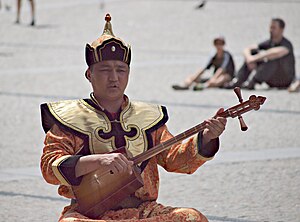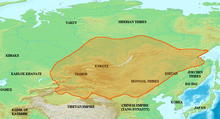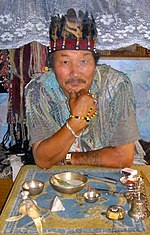Tuvans: Difference between revisions
m Reverted edits by 182.160.6.197 (talk): not adhering to neutral point of view (HG) |
|||
| Line 47: | Line 47: | ||
{{main|Uriankhai}} |
{{main|Uriankhai}} |
||
| ⚫ | There doesn't seem to exist a clear ethnic delineation for the application of the name ''Uriankhai''. Mongols applied this name to all tribes of ''Forest People''. This name has historically been applied to Tuvans. In Mongolia there are peoples also known by this name.<!-- anyone know the story on Mongolian Uriankhai? Know. --> A variation of the name, ''Uraŋxai'', was an old name for the [[Yakuts|Sakha]].<ref>{{cite journal |quotes= |last=POPPE |first=Nicholas |authorlink= |coauthors= |year=1969 |month= |title=Review of Menges "The Turkic Languages and Peoples" |journal=Central Asiatic Journal |volume=12 |issue=4 |pages=330 |id= |url= |accessdate= }}</ref> Russian Pavel Nebol'sin documented the ''Urankhu'' clan of Volga Kalmyks in the 1850s.<ref>{{cite book | last=Mänchen-Helfen | first=Otto | title=Journey to Tuva | origyear=1931 | publisher=Ethnographic Press University of Southern California | location=Los Angeles | isbn= 1-878986-04-X | page=180 | year=1992}}</ref> Another variant of the name, ''Orangkae'' (오랑캐), was traditionally used by the [[Koreans]] to refer indiscriminately to "[[barbarian]]s" that inhabited the lands to their north. |
||
There doesn't seem to exist a clear ethnic delineation for the application of the name ''Uriankhai''. The name means "uria" (motto, war motto) in Mongolian language. |
|||
| ⚫ | Mongols applied |
||
Currently, Tuvans form a large majority of the population in Tuva Republic. According to the 2010 Russian census, there was a total of 249,299 Tuvans who resided within Tuva. This represented 82.0% of the total population of the republic. In addition, Tuvans have a much higher fertility rate than Russians and the other Slavic peoples, while the median age of the Tuvan population is much lower than Russians. This basically ensures that the Tuvan population would continue to grow during the foreseeable future. |
Currently, Tuvans form a large majority of the population in Tuva Republic. According to the 2010 Russian census, there was a total of 249,299 Tuvans who resided within Tuva. This represented 82.0% of the total population of the republic. In addition, Tuvans have a much higher fertility rate than Russians and the other Slavic peoples, while the median age of the Tuvan population is much lower than Russians. This basically ensures that the Tuvan population would continue to grow during the foreseeable future. |
||
| Line 69: | Line 68: | ||
=== Language === |
=== Language === |
||
{{main|Tuvan language}} |
{{main|Tuvan language}} |
||
The Tuvan language belongs to the Northern or Siberian branch of the [[Turkic language]] family |
The Tuvan language belongs to the Northern or Siberian branch of the [[Turkic language]] family. Four dialects are recognized: Central, Western, Southeastern and Northeastern (Todzhinian). The written language is based on [[Cyrillic script|Cyrillic]]. |
||
=== Religion === |
=== Religion === |
||
Revision as of 16:31, 17 December 2013
 Tuvan throat singer. | |
| Regions with significant populations | |
|---|---|
| 263,934[1] | |
| 31,823 (5,169 Tuvans; 26,654 Uriankhai) | |
| ~3,900[2] | |
| 43[3] | |
| Languages | |
| Tuvan, Russian, Mongolian | |
| Religion | |
| Tibetan Buddhism ("Lamaism"), Tengrism | |
| Related ethnic groups | |
| Tofalar, Soyots, several other Turkic peoples and Uriankhai Mongols | |
The Tuvans or Tuvinians (Tuvan: Тывалар, Tyvalar; Mongolian: Tuva Uriankhai) are a Turkic ethnic group living in southern Siberia. They are historically known as one of the Uriankhai, from the Mongolian designation.[4] Tuvans' recent ethnic history is rooted in Mongol, Turkic, and Samoyedic groups of peoples.
Tuvans have historically been cattle-herding nomads, tending to their herds of goats, sheep, camels, reindeer, cattle and yaks for the past thousands of years. They have traditionally lived in yurts covered by felt or chums covered with birch bark or hide that they relocate seasonally as they move to newer pastures. Traditionally Tuvans divided into nine regions called Khoshuun, namely the Tozhu, Salchak, Oyunnar, Khemchik, Khaasuut, Shalyk, Nibazy, Daavan & Choodu, and Beezi. The first four were ruled by Uriankhai Mongol princes, while the rest were administered by Borjigit Mongol princes.[5]
History
Besides prehistoric rock-carvings to be found especially along the Yenisei banks, the first internationally important archaeological findings have been near Arzhan, in the north central Tuva. Here Scythian kurgan burials are being researched, revealing the earliest (7th, 6th century BC) and easternmost remains of these people who spread all the way to Europe. They may be the origin of the occasional and remarkable blond, freckled, green- and blue-eyed Tuvans. Their story and fantastic gold treasures can be appreciated in the National Museum in Kyzyl.
The Xiongnu ruled over the area of Tuva prior to 200 AD. At this time a people known to the Chinese as Dingling inhabited the region. The Chinese recorded the existence of a tribe of Dingling origin named Dubo in the eastern Sayans. This name is recognized as being associated with the Tuvan people and is the earliest written record of them. The Xianbei defeated the Xiongnu and they in turn were defeated by the Rouran. From around the end of the 6th century, the Göktürks held dominion over Tuva up until the 8th century when the Uyghurs took over.

Tuvans were subjects of the Uyghur Khanate during the 8th and 9th centuries. The Uyghurs established several fortifications within Tuva as a means of subduing the population. There are plans being discussed to restore the remains of one of these fortresses, Por-Bazhyn in lake Tere-Khol in the southeast of the country.[6] The memory of Uyghur occupation could still be seen up until the end of the 19th century due to the application of the name Ondar Uyghur for the Ondar Tuvans living near the Khemchik river in the southwest.[7] Uyghur dominance was broken by the Yeniseian Kyrgyz in 840 AD, who came from the upper reaches of the Yenisei.
In 1207, the Oirat prince Quduqa-Beki led Mongol detachments under Jochi to a tributary of the Kaa-Khem river. They encountered the Tuvan Keshdims, Baits, and Teleks. This was the beginning of Mongol suzerainty over the Tuvans. Tuvans came to be ruled for most of the 17th century by Khalka Mongol leader Sholoi Ubashi's Altyn-Khan Khanate. It was at this time in 1615 that the first Russians, V. Tyumenets and I. Petrov, visited Tuva as emissaries to the Altyn-Khan.[8] Russian documents from this time record information about different tribal groups that contributed to the composition of modern Tuvans. Tyumenets and Petrov describe the Maads, who became Russian subjects in 1609, living in the Bii-Khem basin, a 14 day's ride from Tomsk. The Maads travelled to the area of the Khemchik and Ulug-Khem next to the lands of the Altyn-Khan near the lake Uvs Nuur. The ambassadors also described the Sayan raising reindeer with the Tochi (Todzhi) from the Sayan to the Altai mountain ranges. The descendants of the Ak-Sayan and Kara-Sayan live mostly around Tere-Khol rayon.
The state of the Altyn-Khan disappeared due to constant warring between the Oirats and the Khalka of Jasaghtu Khan Aimak. The Tuvans became part of the Dzungarian state ruled by the Oirats. The Dzungars ruled over all of the Sayano-Altay Plateau until 1755. It was during this time of Dzungarian rule that many tribes and clans broke up, moved around, and intermingled. Groups of Altayan Telengits settled in western Tuva on the Khemchik and Barlyk rivers and in the region of Bai-Taiga. Some Todzhans, Sayans, and Mingats ended up in the Altay. Other Tuvans migrated north across the Sayan range and became known as Beltirs (Dag-Kakpyn, Sug-Kakpyn, Ak-Chystar, Kara-Chystar). The languages of the Beltirs and Tuvans still contain common words not found in the language of the other Khakas (Kachins or Sagays).[9] Other Russian documents mention Yeniseian Kyrgyz (Saryglar and Kyrgyz), Orchaks (Oorzhaks) and Kuchugets (Kuzhugets) moving into Tuva from the north.
Besides the Turkic tribes mentioned above, there is indication that modern Tuvans are descended also from Mongolic, Samoyedic, and Kettic groups of peoples. Of the extinct Southern Samoyed groups, Mator, Koibal, Kamas, and Karagas were assimilated mostly into the eastern Tuvans such as the Todzhins, Tofalars, Soyots, and Dukha. The Irgit tribe is also suggested as being from Samoyedic ancestors.[10] The Tuvan name for the Yenisei river may stem from an ancient Samoyedic name.[11] Tribes such as Tumat, Mingat, Mongush, and Salchak are recognized as having a Mongolic origin.[12]
According to Ilya Zakharov of Moscow's Vavilov Institute of General Genetics, genetic evidence suggests that the modern Tuvan people are the closest genetic relatives to the Indigenous peoples of the Americas.[13]
The name Uriankhai

There doesn't seem to exist a clear ethnic delineation for the application of the name Uriankhai. Mongols applied this name to all tribes of Forest People. This name has historically been applied to Tuvans. In Mongolia there are peoples also known by this name. A variation of the name, Uraŋxai, was an old name for the Sakha.[14] Russian Pavel Nebol'sin documented the Urankhu clan of Volga Kalmyks in the 1850s.[15] Another variant of the name, Orangkae (오랑캐), was traditionally used by the Koreans to refer indiscriminately to "barbarians" that inhabited the lands to their north.
Currently, Tuvans form a large majority of the population in Tuva Republic. According to the 2010 Russian census, there was a total of 249,299 Tuvans who resided within Tuva. This represented 82.0% of the total population of the republic. In addition, Tuvans have a much higher fertility rate than Russians and the other Slavic peoples, while the median age of the Tuvan population is much lower than Russians. This basically ensures that the Tuvan population would continue to grow during the foreseeable future.
Geography

There are two major groups of Tuvans in Tuva: Western Tuvans and Tuvans-Todzhins (Тувинцы-тоджинцы). The latter ones live in Todzhinsky District, Tuva Republic and constitute about 5% of all Tuvans.
A people similar by language to Tuvans live in Oka District of Buryatia (autonym: Soyots (сойоты), sometimes referred to as Oka Tuvans).
Mongolia
A noticeable proportion of Tuvans lives in Mongolia. The Dukha live in Khövsgöl Aimag. The largest population of Tuvans in Mongolia are the Tsengel Tuvans.[16] Around 1,500 live in Tsengel Sum of Bayan-Ölgii Aimag. Other Tuvans live in Khovd Aimag and in Ubsunur Hollow.
China
Tuvans in China, who live mostly in the Xinjiang Autonomous Region, are included under the Mongol nationality.[16] Some Tuvans reportedly live at Lake Kanas in the northwestern part of Xinjiang in China where they are not officially recognized, are counted as a part of the local Oirat Mongol community that is counted under the general label 'Mongol'. Oirat and Tuvan children attend schools in which they use Chakhar Mongolian and Chinese, native languages of neither group.
Culture

Language
The Tuvan language belongs to the Northern or Siberian branch of the Turkic language family. Four dialects are recognized: Central, Western, Southeastern and Northeastern (Todzhinian). The written language is based on Cyrillic.
Religion
The traditional religion of Tuvans is a type of Tengriism, or Turkic animistic shamanism. The religion is still widely practiced alongside Tibetan Buddhism.
Music
A unique form of music exists in Tuva commonly known as throat singing or khoomei. There are various techniques of khoomei, some giving the effect of multiple tones by emphasizing overtones. Some famous groups from Tuva who feature throat-singing are Huun-Huur-Tu, Chirgilchin and the Alash Ensemble.
A documentary called Genghis Blues was made in 1999 about an American blues/jazz musician, Paul Pena, who taught himself overtone singing and traveled to Tuva to compete in a throat-singing competition.[17]
See also
Notes
- ^ Russian Census 2010: Population by ethnicity Template:Ru icon
- ^ http://www.joshuaproject.net/people-profile.php
- ^ State statistics committee of Ukraine - National composition of population, 2001 census (Ukrainian)
- ^ "Uriyangqad, which is the plural form of Uriyangqan, itself originally a plural of Uriyangqai."
KRUEGER, John (1977). Tuvan Manual. p. 10. Which quotes from Henry Serruy's "The Mongols in China during the Hung-wu Period", Melanges chinois et bouddhiques, vol 11. pp. 282-283, Brussels 1959. - ^ The Uralic and Altaic Series By Denis Sinor, John R. Krueger, Jüri Kurman, Larry Moses, Robert Arthur Rupen, Vasilij Vasilevič Radlov, Kaare Grłnbech, George Kurman, Joshua A. Fishman, Stephen A. Halkovic, Robert W. Olson, V Diószegi, American Council of Learned Societies, Melvin J. Luthy, Luc Kwanten, Karl Nickul, A. A. Popov, Susan Hesse, Routledge, 1996.
- ^ "Ancient Uigur Fortress on a Tuvan Lake to Turn into a Recreation and Tourist Centre", by Dina Oyun
- ^ KRUEGER, John (1977). Tuvan Manual. p. 41.
which cites from POTAPOV, L.P. (1964). "The Tuvans". The Peoples of Siberia. - ^ KRUEGER, John (1977). Tuvan Manual. p. 25.
which cites from an English translation of Большая Советская Энциклопедия (The Great Soviet Encyclopedia). Vol. 43. 1956.{{cite encyclopedia}}: Missing or empty|title=(help) by William H. Dougherty. - ^ KRUEGER, John (1977). Tuvan Manual. p. 42.
which cites from POTAPOV, L.P. (1964). "The Tuvans". The Peoples of Siberia. - ^ DERENKO, M.V. (2002). "Polymorphism of the Y-Chromosome Diallelic Loci in Ethnic Groups of the Altai-Sayan Region". Russian Journal of Genetics. 38 (3): 309–314. doi:10.1023/A:1014863020171. Archived from the original on 2007-10-22. Retrieved 2010-10-23.
{{cite journal}}: Cite has empty unknown parameter:|quotes=(help); Unknown parameter|coauthors=ignored (|author=suggested) (help); Unknown parameter|month=ignored (help)
Mentions that "some authors" suggest this idea. - ^ VÁSÁRY, I. (1971). "Käm: an Early Samoyed Name of Yenisei". Studia Turcica: 469–482.
{{cite journal}}: Cite has empty unknown parameters:|quotes=,|coauthors=, and|month=(help) - ^ DERENKO, M.V. (2002). "Polymorphism of the Y-Chromosome Diallelic Loci in Ethnic Groups of the Altai-Sayan Region". Russian Journal of Genetics. 38 (3): 309–314. doi:10.1023/A:1014863020171. Archived from the original on 2007-10-22. Retrieved 2010-10-23.
{{cite journal}}: Cite has empty unknown parameter:|quotes=(help); Unknown parameter|coauthors=ignored (|author=suggested) (help); Unknown parameter|month=ignored (help)
Mentions only Mongush and Salchak tribes. - ^ "Central Asian Origins of the Ancestor of First Americans", by I. Zakharov Template:Ru icon
- ^ POPPE, Nicholas (1969). "Review of Menges "The Turkic Languages and Peoples"". Central Asiatic Journal. 12 (4): 330.
{{cite journal}}: Cite has empty unknown parameters:|quotes=,|coauthors=, and|month=(help) - ^ Mänchen-Helfen, Otto (1992) [1931]. Journey to Tuva. Los Angeles: Ethnographic Press University of Southern California. p. 180. ISBN 1-878986-04-X.
- ^ a b Mongush, M. V. "Tuvans of Mongolia and China." International Journal of Central Asian Studies, 1 (1996), 225-243. Talat Tekin, ed. Seoul: Inst. of Asian Culture & Development.
- ^ Genghis Blues (1999)
References
- DERENKO, M.V. (2002). "Polymorphism of the Y-Chromosome Diallelic Loci in Ethnic Groups of the Altai-Sayan Region". Russian Journal of Genetics. 38 (3): 309–314. doi:10.1023/A:1014863020171. Archived from the original on 2007-10-22. Retrieved 2010-10-23.
{{cite journal}}: Cite has empty unknown parameter:|quotes=(help); Unknown parameter|coauthors=ignored (|author=suggested) (help); Unknown parameter|month=ignored (help) - Hoppál, Mihály (2005). Sámánok Eurázsiában (in Hungarian). Budapest: Akadémiai Kiadó. ISBN 963-05-8295-3. The title means “Shamans in Eurasia”, the book is published also in German, Estonian and Finnish. Site of publisher with short description on the book (in Hungarian).
- KRUEGER, John R. (1977). John R. Krueger (ed.). Tuvan Manual. Uralic and Altaic Series Volume 126. Editor Emeritus: Thomas A. Sebeok. Indiana University Publications. ISBN 0-87750-214-5.
- MONGUSH, M.V. (1996). "Tuvans of Mongolia and China". International Journal of Central Asian Studies. 1: 225–243.
{{cite journal}}: Cite has empty unknown parameters:|quotes=,|coauthors=, and|month=(help) - OYUN, Dina (2006-11-16). "Ancient Uigur Fortress on a Tuvan Lake to Turn into a Recreation and Tourist Centre". Tuva Online. Retrieved 2007-02-05.
{{cite news}}: Cite has empty unknown parameter:|coauthors=(help) - PAVLINSKAYA, Larisa R. (2003). "The Troubled Taiga: Survival on the Move for the Lost Nomadic Reindeer Herders of South Siberia, Mongolia, and China". Cultural Survival Quarterly. 27 (1): 45–47. Retrieved 2007-02-05.
{{cite journal}}: Cite has empty unknown parameters:|quotes=and|coauthors=(help); Unknown parameter|month=ignored (help) - XIAOLEI, Jing (2007-01-07). "The Winds of Change". Beijing Review No. 46. Retrieved 2007-02-05.
{{cite news}}: Cite has empty unknown parameter:|coauthors=(help) - ZAKHAROV, I.A. (2003). "Central Asian Origins of the Ancestor of First Americans (Центральноазиатское происхождение предков первых американцев)" (Первые американцы. № 11.). 2003 (in Russian). pp. 139–144. Retrieved 2007-02-05.
{{cite web}}: Cite has empty unknown parameters:|month=and|coauthors=(help)
